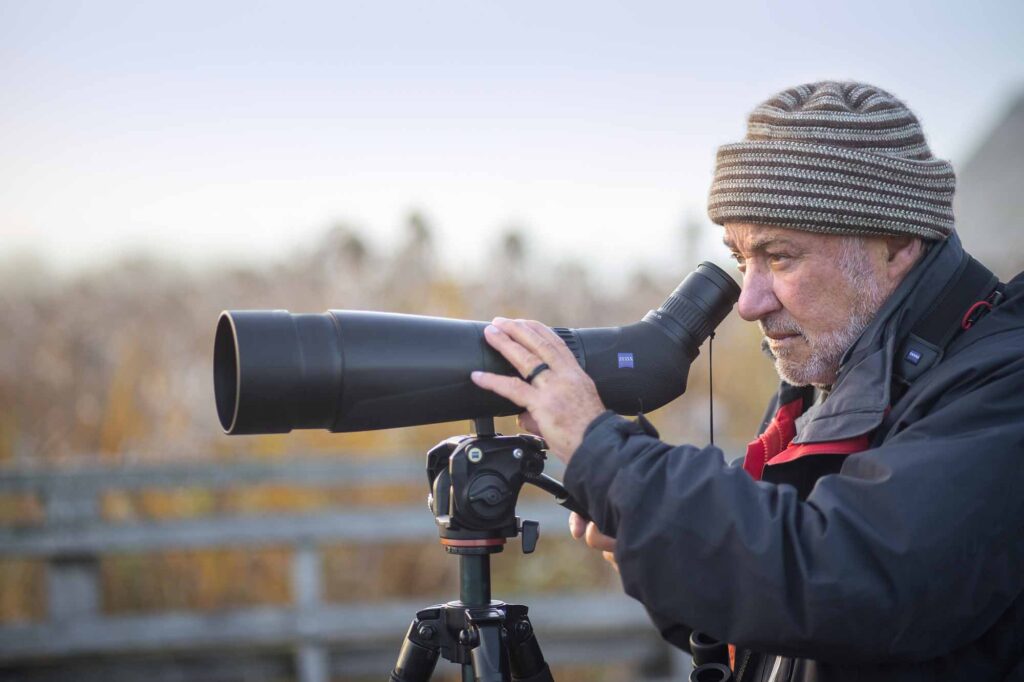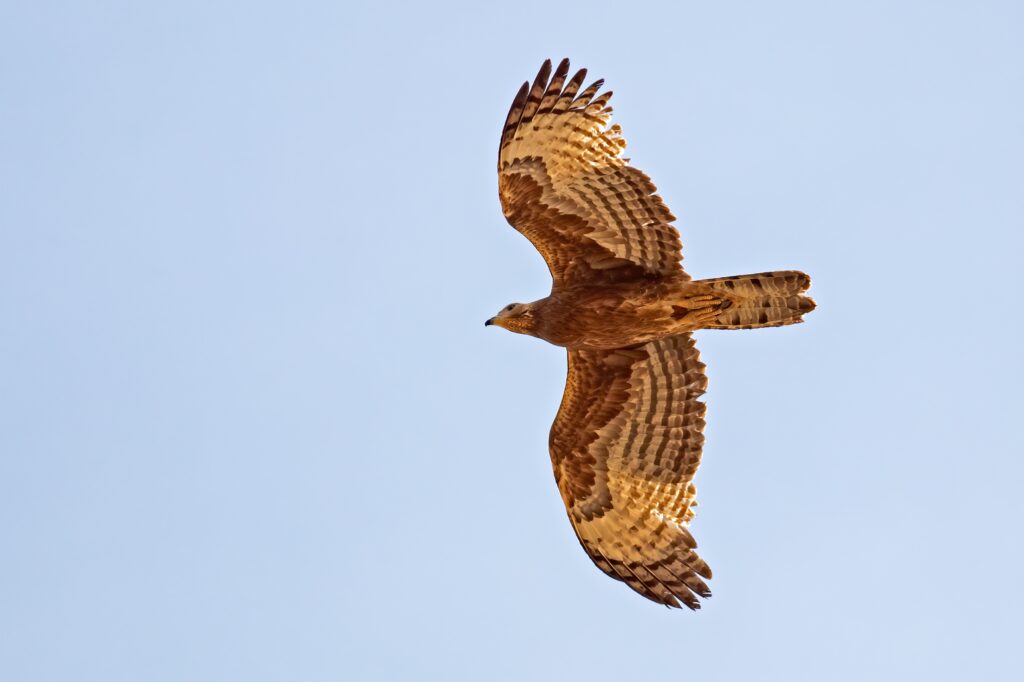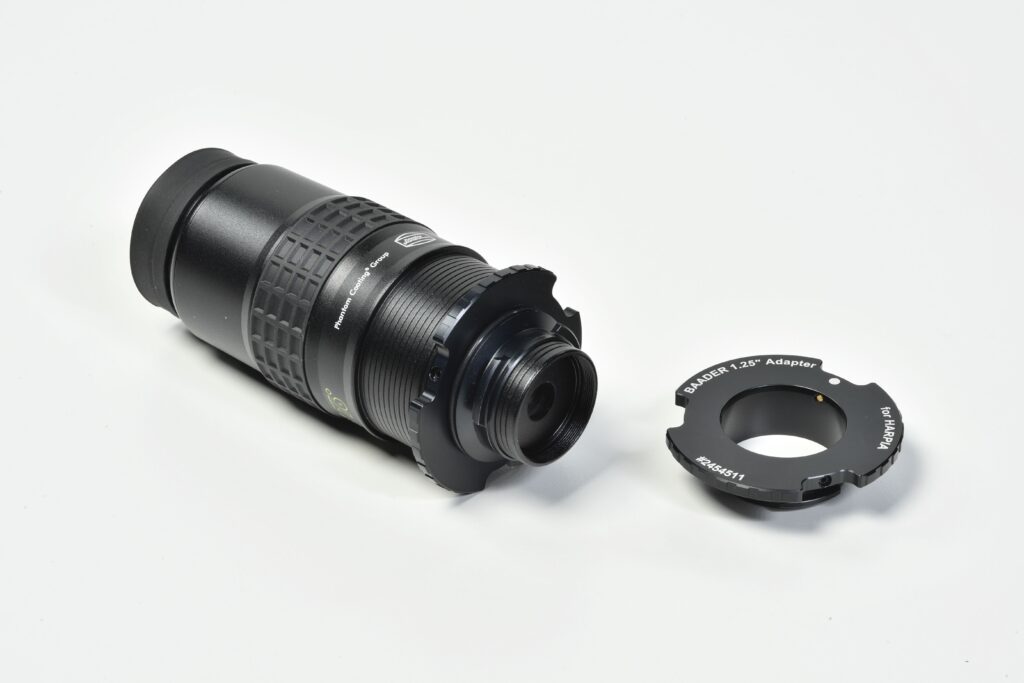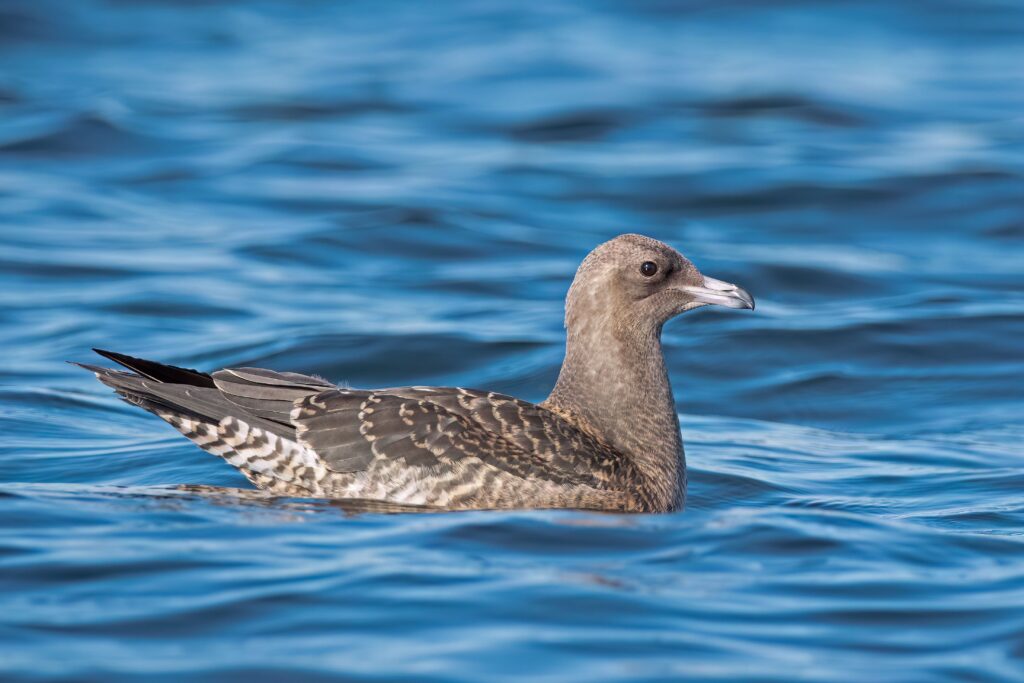As the only spotting scope with objective zoom, the Zeiss Harpia can be further optimized in its outstanding flexibility through the new Baader eyepiece adapter: here in field use with the attached 12.5-millimetre Baader Morpheus eyepiece.

To this end, the revolutionary design of the Zeiss Harpia spotting scope opens up completely new perspectives for the professional birdwatcher in their quest to discover interesting birds more easily and to be able to identify them accurately. The Zeiss Harpia spotting scope excels with its flexibility and dynamics in the field thanks to its zoom unit, which is not located in the eyepiece as is usually the case, but in the front of the objective lens. While the installation of an astro eyepiece with a fixed focal length in conventional spotting scopes limits the resulting magnification to a specific, unchangeable value, the same eyepiece in the Harpia spotting scope does not present us with a fixed magnification, but one that can be changed over a very large threefold zoom range and is therefore flexible.

A large field of view is essential for the detection and reliable counting of migrating birds. The dynamic zoom unit of the Harpia also offers the possibility to temporarily magnify conspicuous individuals for secure identification, such as this Crested Honey Buzzard.
Wide Eyepiece Selection
Through the large range of astronomical eyepieces with a globally standardized 1.25-inch barrel and various focal lengths or magnification powers, the observer has a very large and ultimately only physically limited choice of magnification ranges. The magnification results from dividing the focal length of the objective by the focal length of the eyepiece. Thus, the installation of a 12.5-millimetre astronomical eyepiece in a conventional spotting scope with an objective focal length of, for example, 500 millimetres yields a fixed 40x magnification. In the Zeiss Harpia 95, however, a 12.5-millimetre Morpheus eyepiece does not result in a single fixed magnification, but instead a wide zoom range from 14x to 42x magnification, and with a continuous super wide-angle field of view of 76 degrees: unique and unbeatable for discoveries, but also for better overview when counting birds such as ducks or geese on water or land, as well as for observing migrating birds in the sky.
More Field of View
At 14x magnification, the Harpia in this configuration, with its impressive 76-degree apparent field of view, outperforms not only every threefold zoom eyepiece of conventional spotting scopes but also any 14x binoculars. However, a significant advantage of the Harpia is the ability to zoom up to 42x in just a few seconds, for example, to quickly and reliably identify a Ferruginous Duck in a flock or to confidently distinguish a migrating Lesser Spotted Eagle from a Greater Spotted Eagle. Compared to a current binocular spotting scope with 35x magnification, the Harpia already achieves 50 percent more field of view at the same magnification. By instantly reducing the magnification to 14x, it provides a 900 percent advantage – offering nine times the overview in the sky or terrain.



Occasionally, natural or ethical barriers demand the use of maximum magnification performance for the identification of difficult-to-determine bird species, such as this great skua far off the shoreline.
In many cases, the reliable reading of bird rings requires maximum magnification. The rapid use of short focal length eyepieces with a pre-mounted adapter opens the possibility to achieve the physically attainable maximum resolution.
More Depth of Field
Shifting the zoom range downward results in several advantages: reducing magnification not only produces a larger field of view, but also leads to a significant increase in depth of field, which is of outstanding benefit for waterfowl counts, as birds both farther back and closer to the observer can still be sharply imaged and identified.
More Magnification
Other observation situations, however, require the highest possible magnification beyond the normally available range, such as observations at the sea, large inland lakes, alpine terrain or the edges of restricted nature reserves, as well as for reading rings. This also applies to the identification of distant birds of prey, whose large flight distance prevents close approach. Within seconds, a 4.5-millimetre Morpheus eyepiece equipped with the new adapter can be pulled from a jacket pocket and quickly swapped in, providing a magnification of approximately 40x to 120x on the Harpia 95, to reliably detect barely visible identification features of difficult species when needed. In this way, the modular use of the Harpia objective zoom delivers significant superiority in all field observation scenarios. Of course, the original eyepiece from Zeiss, with a magnification range of 23x to 70x in the 95 model and 22x to 65x in the 85 model, offers the best all-round performance and is unsurpassed by any astronomical third-party eyepiece in terms of image quality, edge sharpness, size and weight. However, the compromises that have to be accepted in terms of viewing comfort, image sharpness, and especially colour neutrality and edge definition, are tolerable for the benefit of supplementary magnification ranges, so that the additional investment is certainly worthwhile for the majority of observers.

Cost-Effective Expansion
Morpheus pulled from the jacket pocket and swapped in “in the blink of an eye” provides a magnification of approximately 40x to 120x on the Harpia 95, enabling the observer to confidently identify barely visible identification features of difficult species when necessary. In this way, the modular use of the Harpia objective zoom delivers significant superiority in all field observation scenarios. Of course, the original eyepiece from Zeiss, with a magnification range of 23x to 70x in the 95 model and 22x to 65x in the 85 model, provides the best all-round performance and cannot be outmatched by any astronomical third-party eyepiece in terms of image quality, edge sharpness, size and weight. However, the compromises that have to be accepted in terms of viewing comfort, image sharpness, and above all, colour neutrality and edge sharpness are tolerable for the benefit of expanded magnification ranges, so that the additional investment is indeed worthwhile for the majority of observers.